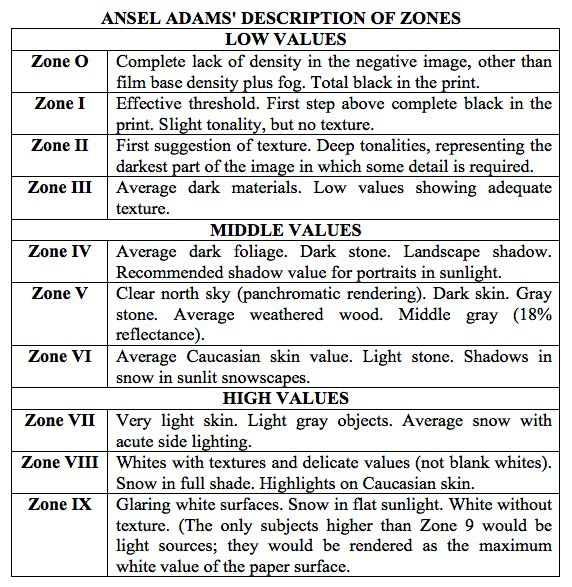 The Zone System is always a controversial subject among serious B&W photographers. Seems there are numerous versions and sub-versions of the system devised by Ansel Adams and Fred Archer. Each artist must choose what works best for them. Like most everything in photography, it is a very personal choice.
The Zone System is always a controversial subject among serious B&W photographers. Seems there are numerous versions and sub-versions of the system devised by Ansel Adams and Fred Archer. Each artist must choose what works best for them. Like most everything in photography, it is a very personal choice.
In the Zone System, the tonal scale from black to white is divided into even steps that are either twice or one half of the previous value. This allows the photographer to translate, or visualize, meter readings into finished print values, or Zones.

Certain elements of the scene to be photographed are sometimes used as a standard reference. Here is how Ansel described Zones;

No matter whether you practice the pure AA Zone System, or any of its variations, there is one aspect that I believe is an invaluable tool for everyone. Speaking in Zones is a universal language, much like math or music. Speaking in Zones allows everyone to find a common way of communicating what they see, what they feel, what they want their interpretation of a subject to be, or what they wish to say.
I am not a Zone System purist in any way. I practice what I have found works best for me. But, I do use Zones, and use the Zone language in everything I do photographically. I prefer its simplicity and ease of expression. I know that if I am discussing an image with a fellow photographer and I say that I placed this area on a particular Zone and this other area fell on another, we are communicating in a common language.
So, whether you are a true-blue ‘Zonie’ or not, I believe everyone should be well acquainted with the language of Zones. In photography, it is a universal language.
JB
 The Zone System is always a controversial subject among serious B&W photographers. Seems there are numerous versions and sub-versions of the system devised by Ansel Adams and Fred Archer. Each artist must choose what works best for them. Like most everything in photography, it is a very personal choice.
The Zone System is always a controversial subject among serious B&W photographers. Seems there are numerous versions and sub-versions of the system devised by Ansel Adams and Fred Archer. Each artist must choose what works best for them. Like most everything in photography, it is a very personal choice. 

